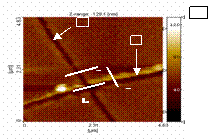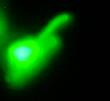Enzyme Nanolithography
|
|
A novel approach to “direct-write” negative nano-lithography, based on biological specificity, where a proteolytic enzyme is used to etch grooves in a hardened protein layer. We are using trypsin to engrave features in a BSA layer, while flowing the trypsin solution via a nano-pipette (controlled by a SPM) to the surface. Trypsin is a proteolytic enzyme that cleaves very specifically on the carboxyl side of lysine and arginine residues. We deliver trypsin solution via a nano-pipette, and control its position with a Scanning Probe Microscope (SPM).
|
1 dehvklvnel tefaktcvad eshagceksl htlfgdelck vaslretygd madccekqep 121 ernecflshk ddspdlpklk pdpntlcdef kadekkfwgk ylyeiarrhp yfyapellyy 181 ankyngvfqe ccqaedkgac llpkietmre kvltssarqr lrcasiqkfg eralkawsva 241 rlsqkfpkae fvevtklvtd ltkvhkecch gdllecaddr adlakyicdn qdtissklke 301 ccdkplleks hciaevekda ipenlpplta dfaedkdvck nyqeakdafl gsflyeysrr 361 hpeyavsvll rlakeyeatl eeccakddph acystvfdkl khlvdepqnl ikqncdqfek 421 lgeygfqnal ivrytrkvpq vstptlvevs rslgkvgtrc ctkpesermp ctedylslil 481 nrlcvlhekt pvsekvtkcc teslvnrrpc fsaltpdety vpkafdeklf tfhadictlp 541 dtekqikkqt alvellkhkp kateeqlktv menfvafvdk ccaaddkeac favegpklvv 601 stqtala
k-lysine r-arginine Amino acid sequence of Bovine Serum Albumin (BSA). |
||
 |

|
 |

|

|

|

|

|
|
Trypsin on BSA, holding the pipette in one place for various time durations |
Trypsin on BSA, while moving the sample relative to the pipette |
Water on BSA, holding the pipette in one place for various time durations
|
Water on BSA, while moving the sample relative to the pipette |

|
(a) Swelling of BSA, water only. (b) Etching of wells, trypsin solution (c) Deduced etching rate of trypsin (difference between (b) and (a))
Swelling starts upon contact, BSA swells and exposes lysine and arginine residues to trypsin, which starts etching some 6.8 seconds later (see V=0 for (c)). Since etching rate is faster than swelling rate (0.0188 > 0.0066), trypsin “wins”, and goes below the original surface after ~8.5 seconds (see V=0 for (b)).
|
||
 100 nm pipette, 200 ms delay (1.5 µm/s) Channel dimensions are influenced by pipette aperture cross-section and writing velocity
|

Etching is additive since the depth of the depression at the intersection is the sum of depths of the channels.
|
 Volume of trypsin delivered is proportional to channel cross-section. The proportion changes with pipette aperture diameter, thus the same volume delivered with a smaller diameter pipette (at a slower writing speed) etches a larger volume than when delivered with a larger diameter pipette. |
|
 A network of channels |
 Fluorescently labeled Avidin flows in BSA channel |
 Avidin deposited with a nanopipette on a channel. |
|
